 Webquest: Growth Through History
Webquest: Growth Through History
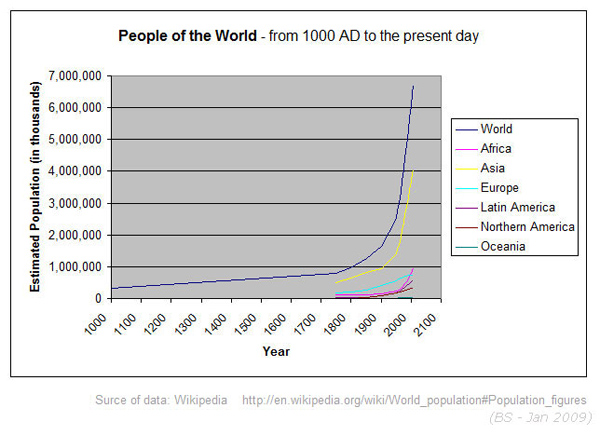
Consider the graph above showing human population growth. What factors led to such a dramatic increase in growth? In the webquest below, you’ll explore the major factors that contributed to early human population growth. Use the webquest worksheet to take notes. Based on the information from the webquest and the PBS World Balance website, answer the following questions about factors that influenced human population growth throughout history.
Answer
Humans began their journey across Earth 60,000 years ago from the continent of Africa. Changes in climate transformed the Sahara Desert into grasslands, making it easier to cross. Early humans also developed larger brains and other body features that enabled them to adapt to different environments and begin to use tools. All of these changes fostered the expansion of humans into other regions of the planet. See the National Geographic website for more information.
Answer
Agriculture was established about 10,000 years ago. When farmers became capable of producing food beyond the needs of their own families, others in their society were free to devote themselves to projects other than food acquisition, and populations began to grow quickly. In the past century, agricultural practices such as irrigation, crop rotation, fertilizers, and pesticides have allowed for even more food to be produced in each unit of land, which fosters an even greater population increase.
Answer
Major medical breakthroughs at the turn of the century helped fuel population growth. Advances in our understanding of the link between sanitation and disease reduced the death rate, and new medications and medical technologies have prolonged life expectancies for most of the world’s population.
Population Size
What factors determine population size? How do these terms affect the size of a population. Click on each to find out more. The population size equals the number of people who die and leave a country taken away from the number born and migrating into a country.
Population Size = (Births + Immigration) – (Deaths + Emigration)
- apes_births
Crude Birth Rate is the number of live births per 1000 people in a population in a given year. The crude birth rate for the United States in 2007 was 14.2. For comparison, in Germany in 2007, the crude birth rate was 8.2.
- apes_deaths
Crude Death Rate is the number of deaths per 1000 people in a population in a given year. In 2007, the crude death rate in the United States was 8.3, while in Tunisia it was 5.2.
- apes_migration
Migration is the movement of people into and out of a country. Movement into a country is called immigration, while movement out of a country is called emigration. Between 2000 and 2009, nearly 9 million people immigrated to the United States. It is estimated that approximately 48,000 people emigrate from the US annually.
Migration
Immigration and emigration play a role in changing the population sizes of countries around the world. Why do you think people choose to enter or leave a country? Read the responses of people in the galleria below to find out.
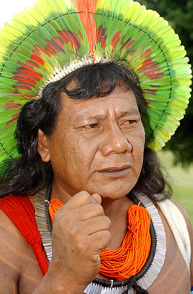 My name is Beatriz and I moved from Brazil to Bolivia due to the environmental degradation of the rainforests in my country. I am from a simple indigenous tribe that lives deep in the Amazon rainforest. Without the materials that the rainforest provides for me and my people, we cannot survive. We hope that our new country of Bolivia will help preserve what is left of our rainforest.
My name is Beatriz and I moved from Brazil to Bolivia due to the environmental degradation of the rainforests in my country. I am from a simple indigenous tribe that lives deep in the Amazon rainforest. Without the materials that the rainforest provides for me and my people, we cannot survive. We hope that our new country of Bolivia will help preserve what is left of our rainforest.
 My name is Ching Lan, and my husband Sheng Li and I left Taiwan for England because of the economic opportunities available there. We have had other family members move to England, and so we followed them in hopes of making our financial dreams come true.
My name is Ching Lan, and my husband Sheng Li and I left Taiwan for England because of the economic opportunities available there. We have had other family members move to England, and so we followed them in hopes of making our financial dreams come true.
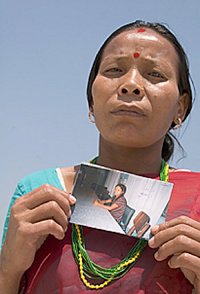 I am Sharesca, and I have left Nepal due to the wars and oppression caused to me and my fellow Nepalese by the Chinese government. In addition, our daughters are being taken away from us and being sold into service by the corrupt governments here. I have moved into India in hopes of finding my daughter and living a life of peace.
I am Sharesca, and I have left Nepal due to the wars and oppression caused to me and my fellow Nepalese by the Chinese government. In addition, our daughters are being taken away from us and being sold into service by the corrupt governments here. I have moved into India in hopes of finding my daughter and living a life of peace.
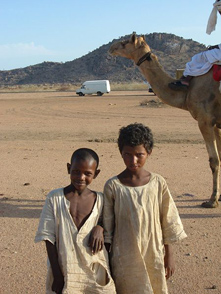 This is Zivan and Faraji. They are orphans from Sudan who have been brought to the United States in the hopes of a better life with a new family. They lost everything they had because of war and political turmoil in their country. Not only this, but the environment was so heavily degraded that many crops can no longer grow there.
This is Zivan and Faraji. They are orphans from Sudan who have been brought to the United States in the hopes of a better life with a new family. They lost everything they had because of war and political turmoil in their country. Not only this, but the environment was so heavily degraded that many crops can no longer grow there.
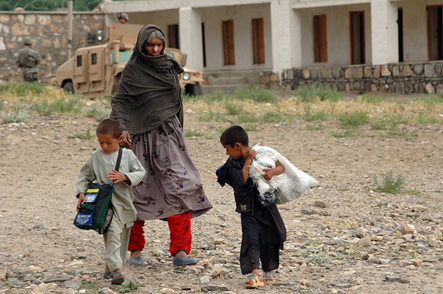 My name is Mastana, and I am a Pashtun from Afghanistan. I am leaving my beloved country to find a more stable place for my boys to grow up; where we will not be persecuted because of our ethnicity. Since I lost my husband to war, I will go live with my family in Pakistan. I hope to find a job and a small home to live and provide regular food and schooling for my boys.
My name is Mastana, and I am a Pashtun from Afghanistan. I am leaving my beloved country to find a more stable place for my boys to grow up; where we will not be persecuted because of our ethnicity. Since I lost my husband to war, I will go live with my family in Pakistan. I hope to find a job and a small home to live and provide regular food and schooling for my boys.
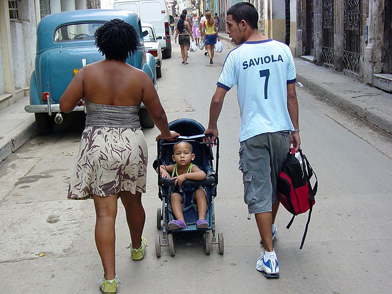 This is Estelle, her husband Carlos and their son Ramon. They are originally from Cuba but have migrated to the US for political asylum and the hope for a better life. Most of their family have also left Cuba and now reside in south Florida.
This is Estelle, her husband Carlos and their son Ramon. They are originally from Cuba but have migrated to the US for political asylum and the hope for a better life. Most of their family have also left Cuba and now reside in south Florida.
To explore immigration in the United States, click the image below to watch the YouTube video from the Business Insider. You can alos view data at teh US Census Bureau: https://www.census.gov/history/www/reference/maps/population_distribution_over_time.html
Avatar: Fertility and Mortality
Population size is measured by adding all the births and subtracting all the deaths, but population experts often use specific terms and data to investigate population growth. Let’s talk to Steven, a doctor who travels the world to help people in need of medical treatment. He may be able to give us some insight into these terms and concepts.
Click the image below.
- apes_puttingbladestogetherforturbine_431x580
Exploration and Discovery – All scientific studies begin with a period of exploration and discovery. Sometimes this involves serendipity, sometimes targeted observations, and sometimes just accidents or chance. Eventually though an interesting question is formed, and that calls for a search for the answer.
- apes_testingmodelwindturbine_300x389
Testing Ideas – To answer a scientific question, you must develop a hypothesis that helps you design a test and then gather and interpret the resulting data to determine where to go next.
- apes_communitymeeting_580x389
Community Analysis and Feedback – In order to come to a strong conclusion, it's necessary for scientists to share and discuss the interpretations of their data.
- apes_windturbines_580x386
Exploration and Discovery – All scientific studies begin with a period of exploration and discovery. Sometimes this involves serendipity, sometimes targeted observations, and sometimes just accidents or chance. Eventually though an interesting question is formed, and that calls for a search for the answer.
putting blades together for wind turbine
Testing Ideas – To answer a scientific question, you must develop a hypothesis that helps you design a test and then gather and interpret the resulting data to determine where to go next.
testing model of wind turbine
Community Analysis and Feedback – In order to come to a strong conclusion, it's necessary for scientists to share and discuss the interpretations of their data.
Community meeting
Benefits and Outcomes – Once a conclusion has been reached, scientific studies can be used to develop new technologies, inform public policy, or just contribute generally to our knowledge base.
Text Version
Video Guide: What Stops Population Growth?
While population experts are busy measuring the fertility rates and mortality rates and migration around the world, the population continues to increase. Have there been any changes to the world’s population growth rates since Thomas Malthus first altered us to the potential danger of exponential growth? As a matter of fact, there have! Hans Rosling, a professor of international health, will show us the positive changes that have been made in that last 60 years in the video below. Use your video guide as you watch to keep track of the big ideas.
Click on the image above to
watch What stops population growth?
Factors that Influence Birth and Death Rates
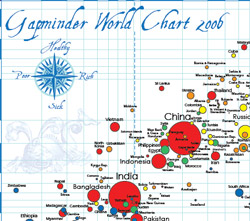
Click the image to see the full size map
”Based on a free chart from www.gapminder.org” Attribution 4.0 International (CC BY 4.0)
Looking at the data presented above, what do you see? There is a difference between life expectancy, wealth, and population growth in developing, developed, and underdeveloped countries. What accounts for these differences? There are many factors that influence birth and death rates.











